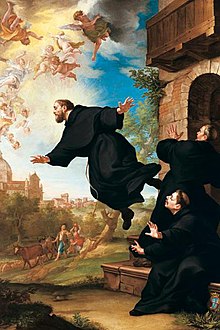Joseph of Cupertino
| Saint Joseph of Cupertino, O.F.M. Conv. |
|
|---|---|

St. Joseph of Cupertino is lifted in flight at the site of the Basilica of Loreto,
by Ludovico Mazzanti (18th century) |
|
| Confessor | |
| Born |
June 17, 1603 Copertino, Apulia, Kingdom of Naples |
| Died | September 18, 1663 (aged 60) Osimo, Marche, Papal States |
| Venerated in |
Roman Catholic Church (Franciscans) |
| Beatified | February 24, 1753, Rome, Papal States, by Pope Benedict XIV |
| Canonized | July 16, 1767, Rome, Papal States, by Pope Clement XIII |
| Major shrine | Basilica of St. Joseph of Cupertino, Piazza Gallo, 10, Osimo, Ancona, Italy |
| Feast | September 18 |
| Patronage | The City of Osimo, aviation, astronauts, mental handicaps, test taking, students |
Joseph of Cupertino, O.F.M. Conv. (Italian: Giuseppe da Copertino) (June 17, 1603 – September 18, 1663) was an Italian Conventual Franciscan friar who is honored as a Christian mystic and saint. He was said to have been remarkably unclever, but prone to miraculous levitation and intense ecstatic visions that left him gaping.
He was born Giuseppe Maria Desa, the son of Felice Desa and Francesca Panara in the village of Cupertino, then in the Province of Apulia, in the Kingdom of Naples, now in the Italian Province of Lecce. His father having died before his birth, however, the family home was seized to settle the large debts he had left, and his mother was forced to give birth to him in a stable.
Joseph began to experience ecstatic visions as a child, which were to continue throughout his life, and made him the object of scorn. His life was not helped by his frequent outbursts of anger. He was soon apprenticed by his uncle to a shoemaker. Feeling drawn to religious life, in 1620 he applied to the Conventual Franciscan friars, but was rejected by them due to his lack of education. He then applied to the Capuchin friars in Martino, near Taranto, by whom he was accepted in 1620 as a lay brother, but was soon dismissed as his continued ecstasies made him unfit for the duties required of him.
After Joseph returned to the scorn of his family, he pleaded with the Conventual friars near Cupertino to be allowed to serve in their stables. After several years of working there, he had so impressed the friars with the devotion and simplicity of his life that he was admitted to their Order, destined to become a Catholic priest, in 1625. He was ordained a priest on March 28, 1628. He was then sent to the Shrine of the Madonna della Grazia, where he spent the next 15 years.
...
Wikipedia
